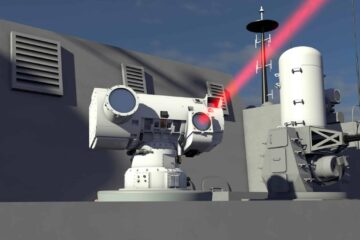Building on existing capability demonstrator projects, and a significant science and technology (S&T) investment over the past decade, the Transition Phase roadmap envisages the fielding of both Laser DEW (LDEW) and Radio Frequency DEW (RFDEW) systems for air defence and counter-unmanned air system (C-UAS) use cases. Planning is already in hand for a possible LDEW fit on the Royal Navy’s (RN’s) new Type 26 frigates.
The MoD in 2019 established a programme to accelerate and exploit DEW capability on the front line as a complement to more conventional kinetic self-defences. A three-year analysis and maturation programme – known as the DEW Concept Phase – is due to complete at the end of the current financial year.
As part of the Concept Phase work, an industry team led by Thales was in 2021 contracted to deliver a maritime LDEW capability demonstrator under Project Tracey. Thales UK’s Belfast site is leading an industry team also including BAE Systems (combat system integration), Chess Dynamics (responsible for a custom-built ultra-high accuracy positioner that will steer and point the laser and an electro-optical targeting pod), Vision4CE (advanced tracking and image processing techniques) and IPG (fibre laser).
The maritime LDEW capability demonstrator system is planned to commence user experimentation trials in 2024. According to the MoD, these will focus on providing user experience and are designed to allow the RN to de-risk operation of high energy lasers in realistic environments.

Under separate S&T funding, a consortium led by MBDA has developed and tested the UK DragonFire LDEW demonstrator in conjunction with the Defence Science and Technology Laboratory (Dstl). The DragonFire testbed has to date completed two trials campaigns, and is being prepared for new tests scheduled to start later this year.
The MoD earlier this month laid out plans for a DEW Transition Phase – funded for at least three years from financial year 2024-2025 – which will mature projects according to three key focus areas: LDEW in a ground-based air defence application; RFDEW in a C-UAS application on land; and LDEW in a maritime air defence application. The work is to be led by the DEW team within the MoD’s Defence Equipment and Support organisation.
One strand that this activity will feed into is Project MIMAS. Naval News understands that this initiative is looking at the retrofit of a 150 kW-class LDEW weapon into the Type 26 frigates from the early 2030s onwards.
Experience from Project MIMAS will inform and de-risk how LDEW effectors could figure in the RN’s projected Future Air Dominance System (FADS), currently planned to enter service around 2035. It is anticipated that LDEW systems would initially be used for C-UAS and short-range anti-air defence as part of the FADS ‘system of systems’; beyond this, there is a possibility that the further maturation of technology could in due course see LDEW systems used for longer range engagements.






